Koi
| Koi fish | |
|---|---|

| |
Domesticated
| |
| Scientific classification | |
| Domain: | Eukaryota |
| Kingdom: | Animalia |
| Phylum: | Chordata |
| Class: | Actinopterygii |
| Order: | Cypriniformes |
| Family: | Cyprinidae |
| Genus: | Cyprinus |
| Species: | |
| Variety: | C. r.var."koi"
|
| Trinomial name | |
| Cyprinus rubrofuscusvar."koi" Linnaeus,1758
| |
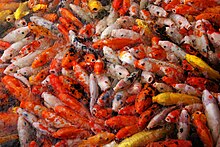
Koi(Lí,English:/ˈkɔɪ/,Japanese:[koꜜi]),or more specificallynishikigoi(Cẩm lí,Japanese:[ɲiɕi̥kiꜜɡoi],literally "brocadedcarp "),are colored varieties of carp (Cyprinussp.) that are kept for decorative purposes in outdoorkoi pondsorwater gardens.
Koi is an informal name for the colored variants of carp kept for ornamental purposes. There are many varieties of ornamental koi, originating from breeding that began inNiigata, Japanin the early 19th century.[1][2][3]
Several varieties are recognized by the Japanese, distinguished by coloration, patterning, and scalation. Some of the major colors are white, black, red, orange, yellow, blue, brown and cream, besides metallic shades like gold and silver-white ('platinum') scales. The most popular category of koi is theGosanke,which is made up of theKōhaku,Taishō SanshokuandShōwa Sanshokuvarieties.
History[edit]
Carpare a large group of fish originally found inCentral EuropeandAsia.Various carp specieswere originallydomesticatedinChina,where they were used as food fish. Carp arecoldwater fish,and their ability to survive and adapt to many climates and water conditions allowed the domesticated species to be propagated to many new locations, including Japan.
Prehistory[edit]
In Japan,Miocenefossils of thecarp family(Cyprinidae) have been excavated fromIki IslandinNagasaki Prefecture.[4]In addition, numerous carppharyngeal teethhave been excavated fromJomonandYayoiperiod sites.[5]For example, pharyngeal teeth of the extinct speciesJōmon Koi(Cyprinus sp.) as well as the present species of carp (Cyprinus carpioorCyprinus rubrofuscus) have been excavated from the Akanoi Bay lakebed site (Xích dã tỉnh loan hồ để di tích) inLake Biwaat the end of the Early Jomon Period (11,500 – 7,000 years ago).[5]In addition, pharyngeal teeth of all six subfamilies of the carp family living in Japan today, including carp, have been found at the Awazu lakebed site (Túc tân hồ để di tích) dating from the Middle Jomon Period (5500 – 4400 years ago).[5]
There are differences in the length distribution of carp excavated from Jomon and Yayoi sites, as estimated from the size of their pharyngeal teeth. Specifically, not only adult carp but also juvenile carp (less than 150 mm in length) have been found at the Yayoi site. This difference is thought to be due to the fact that the Jomon only collected carp from lakes and rivers, while the Yayoi cultivated primitive carp along with the spread of rice paddies.[5][6]
It was previously thought that all Japanese carp were introduced from China in prehistoric times.[7]However, recent analysis ofmitochondrial DNAhas revealed that there are two types of wild carp in Japan: native carp andAmur carpfrom Eurasia, but it is unclear when the Amur carp was introduced to Japan.[8]This is because the oldest record of the introduction of non-native fish in Japan is that of goldfish from China (1502 or 1602),[9]and there is no record of carp (including colored carp) until the introduction of themirror carp,calledDoitsugoi(German carp), in 1904.[10]
Middle Ages[edit]
In the Japanese history bookNihon Shoki(Chronicles of Japan, 720), it is written thatEmperor Keikōreleased carp in a pond for viewing when he visitedMino Province(presentGifu Prefecture) in the fourth year of his reign (74 AD). In Cui Bao'sGǔjīnzhù(Cổ kim chú,Annotations on the Ancient and Modern Period) from theWestern Jin Dynasty(4th century A.D.) in China, carp of the following colors are described: red horse (Xích ký), blue horse (Thanh mã), black horse (Huyền câu), white horse (Bạch kỳ), and yellow pheasant (Hoàng trĩ).[11]In China in those days, carp were called horses because they were believed to be the vehicles of hermits and to run in the sky.
Japan's oldest drug dictionary, Fukane Sukehito'sHonzō Wamyō(Bổn thảo hòa danh,918) mentions red carp (Xích lí), blue carp (Thanh lí), black carp (Hắc lí), white carp (Bạch lí), and yellow carp (Hoàng lí) as Japanese names corresponding to the above Chinese names, suggesting that carp of these colors existed in China and Japan in those days.[12]In addition, Hitomi Hitsudai's drug dictionaryHonchō Shokkan(Bổn triều thực giam,Japanese Medicine Encyclopedia, 1697) states that red, yellow, and white carp of the three colors were in Japan at that time.[13]
However, it is believed that these single-colored carp were not a variety created byartificial selection,as is the case with today's koi, but rather a mutation-induced color change.[14]In ancient times, carp was farmed primarily for food. Mutational color variation in carp is relatively common in nature, but is not suitable for development alongside farming for food in poor rural communities; color inheritance is unstable and selection to maintain color variation is costly. For example, in current-day farming of koi as ornamental fish, the percentage of superior colored fish to the number of spawn is less than 1%.[15]
The Amur carp (Cyprinus rubrofuscus) is a member of the cyprinid familyspecies complexnative toEast Asia.Amur carp were previously identified as a subspecies of the common carp (asC. c. haematopterus), but recent authorities treat it as a separate species under the nameC. rubrofuscus.[16]Amur carp have beenaquaculturedas a food fish at least as long ago as the fifth century BC in China.
Modern period[edit]

The systematic breeding of ornamental Amur carp began in the 1820s in an area known as "Nijūmuragō" (Nhị thập thôn hương,lit. 'twenty villages') which spansOjiyaandYamakoshiinNiigata Prefecture(located on the northeastern coast ofHonshu) in Japan. In Niigata Prefecture, Amur carp were farmed for food in Musubu Shinden, Kanbara County (present Akiba Ward,Niigata City) from the end of theGennaera (1615–1624).[17]In the Nijūmuragō area, carp were also farmed in terraced ponds near terraced rice paddies by 1781 at the latest, but the ponds ran dry due to a severe drought that occurred around that time, and the carp escaped the disaster by taking refuge in ponds on the grounds of Senryu Shrine inHigashiyama Villageand Juni Shrine inHigashitakezawa Village.[18]
During theBunkaandBunseieras (1804 - 1830), people in the Nijūmuragō area bred red and white koi in addition to black koi, and crossed them to produce red and white colored koi. After that, they further crossed them and perfected them.[18]
Around 1875, colored koi became popular and the number of breeders increased, and some expensive koi were produced, but Niigata Prefecture banned the aquaculture of ornamental koi because it was considered a speculative business, and the business suffered a major blow for a time. However, the ban was lifted soon after, thanks to the petition of the villagers. At that time, colored koi includedKōhaku,Asagi,Ki Utsuri,etc.[19]From this original handful of koi varieties, all other Nishikigoi varieties were bred, with the exception of the Ogon variety (single-colored, metallic koi), which was developed relatively recently.[1][3]
Koi breeding flourished in the Nijūmuragō area for two reasons: 1) the custom of raising koi in fallow fields for emergency food during the winter, and 2) the existence of manyinden(Ẩn điền), or hidden rice fields in the mountains, unknown to the lord, which allowed the farmers to avoid taxes and become relatively wealthy. Breeding of koi was promoted as a hobby of farmers who could afford it, and high-quality individuals came to be bought and sold.
The nameNishikigoi(brocaded carp) did not exist until the 1910s. Before that time,Nishikigoiwere calledMadaragoi(Ban lí,lit. 'spotted carp'),Kawarigoi(変 lí,lit. 'variant carp'),Irogoi(Sắc lí,lit. 'colored carp'),Moyōgoi(Mô dạng lí,lit. 'patterned carp'), and so on.
A geographical book onSuruga Province(present-dayShizuoka Prefecture), Abe Masanobu'sSunkoku Zasshi(1843), mentions that in addition to Asagi, purple, red, and white carp, there are "spotted carp (also known as Bekko carp)."[20]This probably refers to two- or three-colored carp caused by mutation, and is a valuable record ofNishikigoiof theEdo period(1603 - 1868).

In 1900, there was a three-colored carp inRitsurin GardeninTakamatsu,Kagawa Prefecture,and the price was over 1,000 yen per fish, which was a high price for that time.[21]The three-colored carp had a red belly andasagi(light blue) back with black spots, and is thought to have been a mutation similar to today'sAsagikoi.
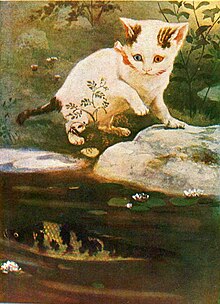
The magazine "Shonen" (1910) introducedNishikigoiunder the name ofMadaragoi(spotted carp) orKawarigoi(variant carp), and said that even skilled fish breeders did not know how they could produceNishikigoi,but only waited for them to be produced by chance.[22]The price ofNishikigoiat a fish show inFukagawa,Tokyo, was 100 to 150 yen per fish, which was "extremely expensive" at the time. Therefore, even at that time, mutantNishikigoiwere known to some fish breeders and hobbyists in Tokyo, but artificial breeds such as Nijūmuragō'sNishikigoiwere still unknown to the general public.
In 1914, when theTokyo Taishō Expositionwas held, the "Koi Exhibit Association" was formed mainly by koi breeders in Higashiyama and Takezawa villages, and koi were exhibited. At the time, they were still called "colored carp" or "patterned carp," and they were described as "the first of their kind ever seen in the Tokyo area." And the koi received much attention, winning a silver medal.[23]After the exposition closed, they presented eight koi to the Crown Prince (Emperor Showa). This exhibition triggered an expansion of sales channels, and the market value of koi soared.
In 1917, theTaishō Sanshoku(by Eizaburo Hoshino) was fixed as a breed. The nameNishikigoiis said to have been given by Kei Abe, who was the chief fisheries officer of the Niigata Prefectural Government in theTaisho era(1912–1926), after he admired theTaishō Sanshokuwhen he first saw it.[24][25]In 1917, the fixation ofKōhaku(by Kunizo Hiroi), which had first been produced in the 1880s, was also assured.[26]
Apart from the koi of Niigata Prefecture's Nijūmuragō area, there is a variety calledShūsui(Thu thúy), which was created by Tokyo-based goldfish breeder Kichigoro Akiyama in 1906 by crossing a femaleleather carpimported from Germany with a male JapaneseAsagior spotted carp.[26]The leather carp is a low scaled variety bred in 1782 in Austria, and was sent to Japan from Munich, Germany in 1904, along with the mirror carp, which also has few scales. In Japan, these two varieties are calledDoitsugoi(German carp), andShūsuiand its lineage are also calledDoitsuorDoitsugoiin koi.
In 1927,Shōwa Sanshoku(by Shigekichi Hoshino) was fixed as a breed, and in 1939, koi were exhibited at the Japanese pavilion at theGolden Gate International Expositionheld in San Francisco.[27]
Today[edit]
The hobby of keeping koi eventually spread worldwide. They are sold in many pet aquarium shops, with higher-quality fish available from specialist dealers.[28][29]Collecting koi has become a social hobby. Passionate hobbyists join clubs, share their knowledge and help each other with their koi.[30]In particular, since the 21st century, some wealthy Chinese have imported large quantities of koi from Niigata in Japan, and the price of high-quality carp has soared. In 2018, one carp was bought by a Chinese collector for about $2 million, the highest price ever. There are also cases in which purchased carp are bred in China and sold to foreign countries, and many breeds are spreading all over the world.[31][32]
Etymology[edit]
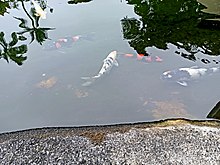
The words "koi" and "nishikigoi" come from the Japanese words lí (carp), and cẩm lí (brocaded carp), respectively. In Japanese, "koi" is ahomophonefor luyến, another word that means "affection" or "love", so koi are symbols of love and friendship in Japan.
Colored ornamental carp were originally calledIrokoi( sắc lí ) meaning colored carp,Hanakoi( hoa lí ) meaning floral carp, andMoyōkoi( mô dạng lí ) meaning patterned carp. There are various theories as to how these words came to be disused, in favor ofNishikigoi( cẩm lí ), which is used today. One theory holds that, duringWorld War II,the wordsIrokoiandHanakoi(which can have sexual meanings) were changed toNishikigoibecause they were not suitable for the social situation of war. Another theory is thatNishikigoi,which was the original name for the popular Taishō Sanshoku variety, gradually became the term used for all ornamental koi.[3]
Taxonomy[edit]
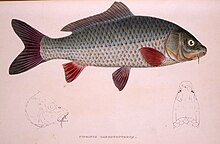

The koi are a group of breeds produced by artificial selection primarily from black carp callednogoi(Dã lí,lit. 'wild carp') ormagoi(Chân lí,lit. 'true carp'), which inhabit lakes, ponds, and rivers in Japan. The black carp refers to theEurasian carp(Cyprinus carpio), which was previously thought to have been introduced to Japan from Eurasia in prehistoric times.
Philipp Franz von Sieboldof the Netherlands, who stayed in Japan during the Edo period, reported inFauna Japonica(1833–1850) that there were three species of carp in Japan:Cyprinus haematopterus,Cyprinus melanotus,andCyprinus conirostris.This classification has not received much attention until recently, and it was thought that only one species of carp existed in Japan. However, recent analysis of mitochondrial DNA has revealed that there are at least two species of carp in Japan: native carp and carp from Eurasia.[8]Currently, the Japanese native carp is assumed to beCyprinus melanotus,and a new scientific name for it is being considered.[33]
Cyprinus haematopterusis thought to refer to theAmur carpof Eurasian origin, traditionally calledYamatogoi(Đại hòa lí,lit. 'carp of Yamato Province') in Japan.Yamatogoihave been famous since the Edo period as farmed carp inYamato Province(nowNara Prefecture). Other carp of the same type asYamatogoiare known asYodogoi(Điến lí,Yodo Rivercarp) fromOsakaandShinshūgoi(Tín châu lí,introducedYodogoi) fromNagano Prefecture.These carp were famous for their delicious taste. Since the Meiji period,Yamatogoihave been released into lakes and rivers throughout Japan, causing genetic contamination with native carp and making research on the origin of the Japanese carp difficult. Koi is thought to be primarily of thisYamatogoi(Amur carp) lineage, but it also carries some genes of the native Japanese carp.[34]
In the past, koi were commonly believed to have been bred from thecommon carp(Cyprinus carpio). Extensivehybridizationbetween different populations, coupled with widespread translocations, has muddled the historicalzoogeographyof the common carp andits relatives.Traditionally,Amur carp(C. rubrofuscus) were considered asubspeciesof the common carp, often under the scientific nameC. carpio haematopterus.However, they differ inmeristicsfrom the common carp of Europe and Western Asia,[16]leading recent authorities to recognize them as a separate species,C. rubrofuscus(C. c. haematopterusbeing ajunior synonym).[35][36]Although one study ofmitochondrial DNA(mtDNA) was unable to find a clear genetic structure matching the geographic populations (possibly because of translocation of carp from separate regions),[37]others based on mtDNA,microsatelliteDNA andgenomic DNAfound a clear separation between the European/West Asian population and the East Asian population, with koi belonging in the latter.[38][39][40]Consequently, recent authorities have suggested that the ancestral species of the koi isC. rubrofuscus(syn.C. c. haematopterus) or at least an East Asian carp species instead ofC. carpio.[16][41]Regardless, ataxonomicreview ofCyprinuscarp from eastern and southeastern Asia may be necessary, as the genetic variations do not fully match the currently recognized species pattern,[39]with one study of mtDNA suggesting that koi are close to the Southeast Asian carp, but not necessarily the Chinese.[42]
Varieties[edit]

According toZen Nippon Airinkai,a group that leads the breeding and dissemination of koi in Japan, there are more than 100 varieties of koi created through breeding, and each variety is classified into 16 groups.[43]Koi varieties are distinguished by coloration, patterning, and scalation. Some of the major colors are white, black, red, yellow, blue, and cream. Metallic shades of gold and platinum in the scales have also been developed through selective breeding. Although the possible colors are virtually limitless, breeders have identified and named a number of specific categories. The most notable category isGosanke(Ngự tam gia),which is made up of theKōhaku,Taishō Sanshoku,andShōwa Sanshokuvarieties.
New koi varieties are still being actively developed.[44]Ghost koi developed in the 1980s have become very popular in theUnited Kingdom;they are ahybridof wild carp and Ogon koi and are distinguished by their metallic scales.Butterfly koi(also known as longfin koi, or dragon carp), also developed in the 1980s, are notable for their long and flowing fins. They are hybrids of koi withAsian carp.Butterfly koi[45]and ghost koi are considered by some to be not truenishikigoi.[46]
The major named varieties include:[43]
- Kōhaku(Hồng bạch)is a white-skinned koi, with large red markings on the top. The name means "red and white";kōhakuwas one of the first ornamental varieties to be established in Japan (late 19th century).[47]
- Taishō Sanshoku(orTaishō Sanke)(Đại chính tam sắc)is very similar to thekōhaku,except for the addition of small black markings calledsumi(Mặc).This variety was first exhibited in 1914 by the koi breeder Gonzo Hiroi, during the reign of theTaishō Emperor.[citation needed]In the United States, the name is often abbreviated to just "Sanke". Thekanji,Tam sắc, may be read as eithersanshokuor assanke(from its earlier name tam mao ).
- Shōwa Sanshoku(orShōwa Sanke)(Chiêu hòa tam sắc)is a black koi with red (hiPhi ) and white (shirojiBạch địa ) markings. The firstShōwa Sankewas exhibited in 1927, during the reign of theShōwa Emperor.In America, the name is often abbreviated to just "Shōwa". The amount ofshirojionShōwa Sankehas increased in modern times (Kindai ShōwaCận đại chiêu hòa ), to the point that it can be difficult to distinguish fromTaishō Sanke.Thekanji,Tam sắc, may be read as eithersanshokuor assanke.
- Bekkō(Miết giáp, べっ giáp)is a white-, red-, or yellow-skinned koi with black markingssumi(Mặc).The Japanese name means "tortoise shell", and is commonly written as miết giáp. The white, red, and yellow varieties are calledShiro Bekkō(Bạch miết giáp),Aka Bekkō(Xích miết giáp)andKi Bekkō(Hoàng miết giáp),respectively. It may be confused with theUtsuri.
- Utsurimono(Tả り vật)is a black koi with white, red, or yellow markings, in azebracolor pattern. The oldest attested form is the yellow form, called "black and yellow markings"(Hắc hoàng ban,Kuro ki madara)in the 19th century, but renamedKi Utsuri(Hoàng tả り)by Elizaburo Hoshino, an early 20th-century koi breeder. The red and white versions are calledHi Utsuri(Phi tả り)andShiro Utsuri(Bạch tả り)(piebald color morph), respectively. The wordutsurimeans to print (the black markings are reminiscent of ink stains). Genetically, it is the same asShōwa,but lacking either red pigment (Shiro Utsuri) or white pigment (Hi Utsuri/Ki Utsuri).
- Asagi(Thiển hoàng)koi is light blue above and usually red below, but also occasionally pale yellow or cream, generally below the lateral line and on the cheeks. The Japanese name means pale greenish-blue,spring onioncolor, orindigo.
- 'Shūsui(Thu thúy)means "autumn green"; theShūsuiwas created in 1910 by Yoshigoro Akiyama (Thu sơn cát ngũ lang,by crossing JapaneseAsagiwith Germanmirror carp.[citation needed]The fish has no scales, except for a single line of large mirror scales dorsally, extending from head to tail. The most common type ofShūsuihas a pale,sky-blue/gray color above the lateral line and red or orange (and very, very rarely bright yellow) below the lateral line and on the cheeks.
- Koromo(Y)is a white fish with aKōhaku-style pattern with blue or black-edged scales only over thehipattern. This variety first arose in the 1950s as a cross between aKōhakuand anAsagi.[citation needed]The most commonly encounteredKoromois anAi Goromo(Lam y),which is colored like aKōhaku,except each of the scales within the red patches has a blue or black edge to it. Less common is theBudō-Goromo(Bồ đào y),which has a darker (burgundy)hioverlay that gives it the appearance of bunches of grapes. Very rarely seen is theSumi-Goromo(Mặc y),which is similar toBudō-Goromo,but thehipattern is such a dark burgundy that it appears nearly black.
- Kawarimono(変わり vật)is a "catch-all" term for koi that cannot be put into one of the other categories. This is a competition category, and many new varieties of koi compete in this one category. It is also known askawarigoi(変わり lí).[citation needed]
- Goshiki(Ngũ sắc)is a dark koi with red (Kōhakustyle)hipattern. The Japanese name means "five colors". It appears similar to anAsagi,with little or nohibelow the lateral line and aKōhaku Hipattern over reticulated (fishnet pattern) scales. The base color can range from nearly black to very pale, sky blue.
- Hikari-mujiimono(Quang vô địa もの)is a variety of which the whole body is one color and the body is shiny, and it is called differently depending on the color.
- Hikari-moyomono(Quang mô dạng もの)is a koi with colored markings over a metallic base or in two metallic colors.
- Hikari-utsurimono(Quang tả りもの)is a cross betweenutsurimonoseries andŌgon.
- Kinginrin(Kim ngân lân)is a koi with metallic (glittering, metal-flake-appearing) scales. The name translates into English as "gold and silver scales"; it is often abbreviated toGinrin.Ginrinversions of almost all other varieties of koi occur, and they are fashionable. Their sparkling, glittering scales contrast to the smooth, even, metallic skin and scales seen in theOgonvarieties. Recently, these characteristics have been combined to create the newginrin Ogonvarieties.
- Tanchō(Đan đỉnh)is any koi with a solitary red patch on its head. The fish may be aTanchō Shōwa,Tanchō Sanke,or evenTanchō Goshiki.It is named for the Japanesered-crowned crane(Grus japonensis), which also has a red spot on its head.
- Chagoi(Trà lí),"tea-colored", this koi can range in color from pale olive-drab green or brown to copper or bronze and more recently, darker, subdued orange shades. Famous for its docile, friendly personality and large size, it is considered a sign of good luck among koi keepers.
- Ōgon(Hoàng kim)is a metallic koi of one color only (hikarimonoQuang giả ). The most commonly encountered colors are gold, platinum, and orange. Cream specimens are very rare.Ogoncompete in theKawarimonocategory and the Japanese name means "gold". The variety was created by Sawata Aoki in 1946 from wild carp he caught in 1921.
- Kumonryū(Cửu văn long)' ( literally "nine tattooed dragons" is a blackdoitsu-scaled fish with curling white markings. The patterns are thought to be reminiscent of Japanese ink paintings of dragons. They famously change color with the seasons.[48]Kumonryucompete in theKawarimonocategory.
- Ochiba(Lạc diệp)is a light blue/gray koi with copper, bronze, or yellow (Kohaku-style) pattern, reminiscent of autumn leaves on water. The Japanese name means "fallen leaves".
- Kikokuryū( huy hắc long, literally "sparkle" or "glitter black dragon" ) is a metallic-skinned version of theKumonryu.
- Kin-Kikokuryū( kim huy hắc long, literally "gold sparkle black dragon" or "gold glitter black dragon" ) is a metallic-skinned version of theKumonryuwith aKōhaku-stylehipattern developed by Mr. Seiki Igarashi of Ojiya City. At least six different genetic subvarieties of this general variety are seen.
- Ghost koi (Nhân diện ngư,じんめんぎょ), a hybrid ofOgonand wild carp with metallic scales, is considered by some to be notnishikigoi.
- Butterfly koi(Kỳ trường cẩm lí,ひれながにしきごい) is a hybrid of koi and Asian carp with long flowing fins. Various colorations depend on the koi stock used to cross. It also is considered by some to not benishikigoi.
- Doitsu-goi(ドイツ lí)originated by crossbreeding numerous different established varieties with "scaleless"German carp(generally, fish with only a single line of scales along each side of the dorsal fin). Also written as độc dật lí, four main types ofDoitsuscale patterns exist. The most common type (referred to above) has a row of scales beginning at the front of the dorsal fin and ending at the end of the dorsal fin (along both sides of the fin). The second type has a row of scales beginning where the head meets the shoulder and running the entire length of the fish (along both sides). The third type is the same as the second, with the addition of a line of (often quite large) scales running along the lateral line (along the side) of the fish, also referred to as "mirror koi". The fourth (and rarest) type is referred to as "armor koi" and is completely (or nearly) covered with very large scales that resemble plates of armor. It also is calledKagami-goi( kính lí, カガミゴイ), or mirror carp (ミラーカープ).
-
Kōhaku
-
Tanchō Sanke
-
Shōwa Sanke
-
Asagi
-
Bekkō
-
Gin Rin Shōwa
Differences from goldfish[edit]
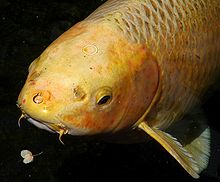
Goldfish(Carassius auratus) were developed inChinamore than a thousand years ago byselectively breedingcolored varieties; by theSong dynasty(960–1279), yellow, orange, white, and red-and-white colorations had been developed. Goldfish were introduced to Japan in the 16th century and to Europe in the 17th century.[49]On the other hand, most ornamental koi breeds currently distributed worldwide originate from Amur carp (Cyprinus rubrofuscus) bred in Japan in the first half of the 19th century. Koi are domesticated Amur carp that are selected or culled for color; they are not a different species, and will revert to the original coloration within a few generations if allowed to breed freely.
Some goldfish varieties, such as thecommon goldfish,comet goldfish,andshubunkin,have body shapes and coloration that are similar to koi, and can be difficult to tell apart from koi when immature.[50]Goldfish and koi can interbreed; however, as they were developed from different species of carp, their offspring are sterile.[51][52]
Health, maintenance, and longevity[edit]
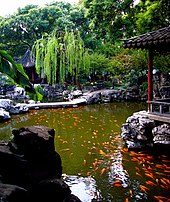
The Amur carp is a hardy fish, and koi retain that durability. Koi are coldwater fish, but benefit from being kept in the 15–25 °C (59–77 °F) range, and do not react well to long, cold, winter temperatures; their immune systems are very weak below 10 °C (50 °F). Koi ponds usually have a metre or more of depth in areas of the world that become warm during the summer, whereas in areas that have harsher winters, ponds generally have a minimum of 1.5 m (5 ft). Specific pond construction has been evolved by koi keepers intent on raising show-quality koi.
The bright colors of koi put them at a severe disadvantage against predators; a white-skinnedKōhakuis highly noticeable against the dark green of a pond.Herons,kingfishers,otters,raccoons,skunk,mink,cats,foxes,andbadgersare all capable of spotting out koi and eating them.[48]A well-designed outdoor pond has areas too deep for herons to stand, overhangs high enough above the water that mammals cannot reach in, and shade trees overhead to block the view of aerial passers-by. It may prove necessary to string nets or wires above the surface. A pond usually includes apumpand afiltrationsystem to keep the water clear.
Koi are an omnivorous fish. They eat a wide variety of foods, including peas, lettuce, and watermelon. Koi food is designed not only to be nutritionally balanced, but also to float so as to encourage them to come to the surface. When they are eating, koi can be checked for parasites and ulcers. Naturally, koi are bottom feeders with a mouth configuration adapted for that. Some koi have a tendency to eat mostly from the bottom, so food producers create a mixed sinking and floating combination food. Koi recognize the persons feeding them and gather around them at feeding times. They can be trained to take food from one's hand.[53]In the winter, their digestive systems slow nearly to a halt, and they eat very little, perhaps no more than nibbles of algae from the bottom. Feeding is not recommended when the water temperature drops below 10 °C (50 °F).[54][55]Care should be taken by hobbyists that proper oxygenation, pH stabilization, and off-gassing occur over the winter in small ponds. Their appetites do not come back until the water becomes warm in the spring.
Koi have been reported to achieve ages of 100–200 years.[56]One famous scarlet koi named "Hanako"was owned by several individuals, the last of whom was Komei Koshihara. In July 1974, a study of thegrowth ringsof one of the koi's scales reported that Hanako was 226 years old.[57]Some sources give an accepted age for the species at little more than 50 years.[58][59]
Disease[edit]
Koi are very hardy. With proper care, they resist many of the parasites that affect more sensitive tropical fish species, such asTrichodina,Epistylis,andIchthyophthirius multifiliisinfections. Water changes help reduce the risk of diseases and keep koi from being stressed. Two of the biggest health concerns among koi breeders are thekoi herpes virus(KHV[60]) andrhabdoviruscarpio, which causesspring viraemia of carp(SVC). No treatment is known for either disease. Some koi farms in Israel use the KV3 vaccine, developed by M. Kotler from theHebrew University of Jerusalemand produced by Kovax, to immunise fish against KHV. Israel is currently the only country in the world to vaccinate koi against the KHV. The vaccine is injected into the fish when they are under one year old, and is accentuated by using anultravioletlight. The vaccine has a 90% success rate[61]and when immunized, the fish cannot succumb to a KHV outbreak and neither can the immunised koi pass KHV onto other fish in a pond.[62]Onlybiosecuritymeasures such as prompt detection,isolation,anddisinfectionof tanks and equipment can prevent the spread of the disease and limit the loss of fish stock. In 2002, spring viraemia struck an ornamental koi farm inKernersville, North Carolina,and required complete depopulation of the ponds and a lengthy quarantine period. For a while after this, some koi farmers in neighboring states stopped importing fish for fear of infecting their own stocks.[63][64]
Breeding[edit]
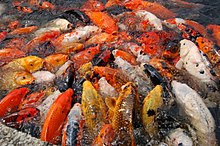
When koi naturally breed on their own they tend to spawn in the spring and summer seasons. The male will start following the female, swimming right behind her and nudging her. After the female koi releases her eggs they sink to the bottom of the pond and stay there. A sticky outer shell around the egg helps keep it in place so it does not float around. Although the female can produce many spawns, many of the fry do not survive due to being eaten by others.
Like most fish, koi reproduce through spawning in which a female lays a vast number of eggs and one or more males fertilize them. Nurturing the resulting offspring (referred to as "fry" ) is a tricky and tedious job, usually done only by professionals. Although a koi breeder may carefully select the parents they wish based on their desired characteristics, the resulting fry nonetheless exhibit a wide range of color and quality.
Koi produce thousands of offspring from a single spawning. However, unlike cattle, purebred dogs, or more relevantly, goldfish, the large majority of these offspring, even from the best champion-grade koi, are not acceptable asnishikigoi(they have no interesting colors) or may even be genetically defective. These unacceptable offspring are culled at various stages of development based on the breeder's expert eye and closely guarded trade techniques. Culled fry are usually destroyed or used as feeder fish (mostly used for feedingarowanadue to the belief that it will enhance its color), while older culls, within their first year between 3 and 6 inches long (also calledtosai[65]), are often sold as lower-grade, pond-quality koi.
The semi-randomized result of the koi's reproductive process has both advantages and disadvantages for the breeder. While it requires diligent oversight to narrow down the favorable result that the breeder wants, it also makes possible the development of new varieties of koi within relatively few generations.
In the wild[edit]

Koi have been accidentally or deliberately released into the wild in every continent exceptAntarctica.They quickly revert to the natural coloration of an Amur carp within a few generations. In many areas, they are considered aninvasive speciesand apest.In the states ofQueenslandandNew South Walesin Australia, they are considered noxious fish.[66][67]
Koi greatly increase theturbidityof the water because they are constantly stirring up the substrate. This makes waterways unattractive, reduces the abundance of aquatic plants, and can render the water unsuitable for swimming or drinking, even by livestock. In some countries, koi have caused so much damage to waterways that vast amounts of money and effort have been spent trying to eradicate them, largely unsuccessfully.[68]
In many areas of North America, koi are introduced into the artificial "water hazards"and ponds on golf courses to keep water-borne insect larvae under control through predation.
In common culture[edit]

In Japan, the koi is a symbol ofluck,prosperity,andgood fortune,and also ofperseverancein the face of adversity.[69]Ornamental koi are symbolic ofJapanese cultureand are closely associated with the country's national identity.[70]The custom ofkoinobori(carp streamers), which began in theEdo period(1603–1867), is still practiced today and displayed in gardens onChildren's Day,5 May.[71]
In Chinese culture, the koi representsfame,family harmony,andwealth.It is afeng shuifavorite, symbolizing abundance as well as perseverance and strength, and has a mythical potential to transform into adragon.[72]Since the late 20th century, the keeping of koi in outdoorwater gardenshas become popular among the more affluent Chinese.Koi pondsare found in Chinese communities around the world, and the number of people who keep koi imported fromNiigata,has been increasing. In addition, there are increasing numbers of Japanese koi bred in China that are sold domestically and exported to foreign countries.[31][32]
Koi are also popular in many countries in the equatorial region, where outdoor water gardens are popular.[73]InSri Lanka,interior courtyards most often have one or several fish ponds dedicated to koi.[74]
See also[edit]
References[edit]
- ^abJapanese Ornamental Koi Carp: Origin, Variation and GeneticsArchived20 December 2020 at theWayback MachineMay 2015
- ^abOjiya Nishikigoi no Sato Museum
- ^abcThe History of Nishikigoi cẩm lí とその khởi nguyênZen Nippon Airinkai
- ^Yabumoto, Yoshitaka (2010). "Ikiculter chojabaruensis, a New Genus and Species of Cyprinid Fish from the Miocene of Iki Island, Nagasaki, Japan".Paleontological Research.14(4): 277–292.doi:10.2517/1342-8144-14.4.277.S2CID85972532.
- ^abcdNakajima, Tsuneo (31 January 2011). "コイ khoa ngư loại yết đầu xỉ di tồn thể から kiến える tiên sử thời đại の ngư lao と đạo tác との quan hệ に quan する nhất khảo sát" [A Speculation on Relationships between Freshwater Fishing and Rice Cultivation in Prehistoric Ages from a Viewpoint of Tooth Remains of Carps].Bulletin of the National Museum of Japanese History.162.National Museum of Japanese History: 49–63.doi:10.15024/00001857.
- ^Nakajima, T.; Nakajima, M.; Yamazaki, T. (2010). "Evidence for fish cultivation during the Yayoi Period in western Japan".International Journal of Osteoarchaeology.20(2): 127–134.doi:10.1002/oa.1005.
- ^Jordan, David Starr; Fowler, Henry W (1903)."A review of the cyprinoid fishes of Japan".Proc. U.S. Natl. Mus.26(1334): 811–862.doi:10.5479/si.00963801.26-1334.811.Archivedfrom the original on 14 March 2023.Retrieved4 January2024.
- ^abMabuchi, K.; Senou, H.; Suzuki, T.; Nishida, M. (June 2005)."Discovery of an ancient lineage of Cyprinus carpio from Lake Biwa, central Japan, based on mtDNA sequence data, with reference to possible multiple origins of koi".Journal of Fish Biology.66(6): 1516–1528.Bibcode:2005JFBio..66.1516M.doi:10.1111/j.0022-1112.2005.00676.x.ISSN0022-1112.Archivedfrom the original on 10 October 2023.Retrieved3 October2023.
- ^Quốc thư khan hành hội (1915). Kokusho Kanko-kai (ed.).Tạp vân tùng thư[Miscellaneous Art Series]. Vol. 1. Kokusho Kan-kai. p. 265.doi:10.11501/1869566.
- ^Maruyama, Tamezo (March 1987).Ngoại quốc sản tân ngư chủng の đạo nhập kinh quá[Progress of introduction of new foreign fish species]. Fisheries Agency, Research Department, Resources Division.
- ^"Cổ kim chú - duy cơ văn khố, tự do đích đồ thư quán".zh.wikisource.org.Archivedfrom the original on 2 October 2023.Retrieved3 October2023.
- ^Thâm giang, phụ nhân, bình an trung kỳ; dữ tạ dã, khoan, 1873-1935 (1927). Fukae, Sukehito (ed.).Bổn thảo hòa danh[Honzō Wamyō]. Vol. 2. Japan Society for the Publication of Complete Works of Classical Japanese Literature. p. 19.doi:10.11501/1111774.
{{cite book}}:CS1 maint: multiple names: authors list (link) CS1 maint: numeric names: authors list (link) - ^Hitomi, Hitsudai (1697).Bổn triều thực giam[Japanese Medicine Encyclopedia]. Vol. 7. Hirano Uji Denzaemon, Hiranoya Katsuzaemon.doi:10.11501/2569419.
- ^Nakajima, Kenji (January 1976)."Ngư bệnh học cơ sở giảng tọa ( cẩm lí thiên )1"[Basic Fish Pathology (Nishikigoi) 1].Journal of the Japan Veterinary Medical Association.29(1). Japan Veterinary Medical Association: 20–24.doi:10.12935/jvma1951.29.20.ISSN0446-6454.Archivedfrom the original on 27 September 2023.Retrieved3 October2023.
- ^Xuyên bổn, tín chi, 1898-1985 (1967). Kawamoto, Nobuyuki (ed.).Dưỡng ngư học các luận[Introduction to Fish Farming]. Koseisha Koseikaku. p. 59.doi:10.11501/2513721.
{{cite book}}:CS1 maint: multiple names: authors list (link) CS1 maint: numeric names: authors list (link) - ^abcFreyhof, J.; Kottelat, M. (2008)."Cyprinus carpio".IUCN Red List of Threatened Species.2008:e.T6181A12559362.doi:10.2305/IUCN.UK.2008.RLTS.T6181A12559362.en.Retrieved11 November2021.
- ^Fujita, Masakatsu (November 1906).Dưỡng ngư kinh 営 học[Fish Farming Management]. Suisan Shoin. p. 18.doi:10.11501/802628.
- ^abĐông kinh phủ (1916). Tokyo Prefecture (ed.).Đông kinh đại chính bác lãm hội thẩm tra báo cáo[Tokyo Taisho Exposition Examination Report]. Vol. 2. Tokyo Prefecture. p. 861.doi:10.11501/954707.
- ^Tân tả huyện thủy sản thí nghiệm tràng (1931). Niigata Prefectural Fisheries Experiment Station (ed.).Nông gia の phó nghiệp đích dưỡng ngư pháp[Farmers' Sideline Fish Farming Methods]. Vol. 1. Niigata Agricultural Society. p. 100.doi:10.11501/1226542.
- ^Abe, Masanobu (February 1977).Tuấn quốc tạp chí 2[Suruga Miscellaneous Records 2]. Yoshimi Shoten. p. 311.doi:10.11501/9537491.
- ^Miyoshi, Otojiro (1903).Kim ngư vấn đáp[Goldfish Question and Answer]. Mataoma Yasujiro. p. 79.doi:10.11501/904129.
- ^Toyama, Kametaro (June 1910). "Kim ngân mục の miêu と nguyên bình tiếu biệt の hoa" [Cat with gold and silver eyes and blooming flowers of two mixed colors].Shōnen.No. 82. Jijishinposha. p. 143.doi:10.11501/1793889.
- ^Đông kinh đại chính bác lãm hội (1914). Tokyo Taisho Exposition (ed.).Đông kinh đại chính bác lãm hội xuất phẩm thẩm tra khái huống: Phụ ・ thụ thưởng nhân danh bộ[Overview of the Judging of Exhibits at the Tokyo Taisho Exposition]. Tokyo Taisho Exposition Memorial Book Publishing Society. p. 63.doi:10.11501/951452.
- ^Tanaka, Shigeho (1936).Nhật bổn の ngư loại[Fish of Japan]. Dai Nippon Tosho. p. 319.
- ^"Niên 々, nhân khí thượng thăng trung! Cẩm lí の mị lực"[Increasingly popular every year! Attraction of Nishikigoi].aff.Ministry of Agriculture, Forestry and Fisheries. August 2023.Archivedfrom the original on 7 October 2023.Retrieved7 October2023.
- ^abĐức gian thư điếm (1966). Tokuma Shoten (ed.).Cẩm lí の mị lực: Vịnh ぐ bảo thạch を dục てるために[Attraction of Nishikigoi: To raise swimming jewels]. Tokuma Shoten.doi:10.11501/2510714.
- ^Thương công tỉnh giam lý cục (1941). Supervisory Bureau of the Ministry of Commerce and Industry (ed.).Nữu dục kim môn vạn quốc bác lãm hội chính phủ tham đồng sự vụ báo cáo thư[Report of the Government Visit to theGolden Gate International Exposition]. Supervisory Bureau of the Ministry of Commerce and Industry. p. 122.doi:10.11501/1716726.
- ^"MPKS Ray Jordan Koi History".Ray Jordan. Archived fromthe originalon 23 July 2009.Retrieved26 April2009.
- ^"Early Records".Netpets.org.Archivedfrom the original on 13 June 2010.Retrieved11 April2009.
- ^Fletcher, Nick (1 January 1999).The Ultimate Koi.Interpet.ISBN978-1-86054-146-9.Archivedfrom the original on 16 May 2024.Retrieved18 October2020.
- ^abThe reason why wealthy Chinese started to buy a lot of Japanese "nishikigoi" 1/3,Gendai Business. 29 March 2019.
- ^abThe reason why wealthy Chinese started to buy a lot of Japanese "nishikigoi" 3/3,Gendai Business. 29 March 2019.
- ^Seno, Hiroshi (2010)."Nhật bổn sản コイ(コイ mục コイ khoa )のルーツ giải minh と bảo toàn へのシナリオ"[Elucidation of the Roots of Japanese Carp and Scenarios for Conservation]. KAKEN.Archivedfrom the original on 16 May 2024.Retrieved8 October2023.
- ^Higuchi, Masahito (23 August 2023). "ミトコンドリア DNA điều tiết lĩnh vực の diêm cơ phối liệt からみたニシキゴイの di vân đích 変 dị とその khởi nguyên" [Genetic variability and ancient origin of the Japanese ornamental carp (koi) using the nucleotide sequences of mitochondrial DNA control region].Aquatic Animals.2023.0_AA2023-18. Aquos Institute.doi:10.34394/aquaticanimals.2023.0_AA2023-18.
- ^Huckstorf, V. (2012)."Cyprinus rubrofuscus".IUCN Red List of Threatened Species.2012:e.T166052A1108337.doi:10.2305/IUCN.UK.2012-1.RLTS.T166052A1108337.en.Retrieved11 November2021.
- ^Froese, Rainer; Pauly, Daniel (eds.) (2016)."Cyprinus rubrofuscus"inFishBase.November 2016 version.
- ^Mabuchi, K.; Senou, H.; Suzuki, T.; Nishida, M. (2005). "Discovery of an ancient lineage ofCyprinus carpiofrom Lake Biwa, central Japan, based on mtDNA sequence data, with reference to possible multiple origins of koi ".Journal of Fish Biology.66(6): 1516.Bibcode:2005JFBio..66.1516M.doi:10.1111/j.0022-1112.2005.00676.x.
- ^Grossa, Riho; Klaus Kohlmannb & Petra Kerstenb (2002). "PCR–RFLP analysis of the mitochondrial ND-3/4 and ND-5/6 gene polymorphisms in the European and East Asian subspecies of common carp (Cyprinus carpioL.) ".Aquaculture.204(3–4): 507–516.Bibcode:2002Aquac.204..507G.doi:10.1016/S0044-8486(01)00836-5.
- ^abChistiakov, D.A.; Voronova, N.V (2009)."Genetic evolution and diversity of common carpCyprinus carpioL. "Central European Journal of Biology.4(3): 304–312.doi:10.2478/s11535-009-0024-2.
- ^Xu, P.; et al. (2014)."Genome sequence and genetic diversity of the common carp,Cyprinus carpio".Nature Genetics.46(11): 1212–1219.doi:10.1038/ng.3098.PMID25240282.
- ^Craig, J.F. (2015).Freshwater Fisheries Ecology.Wiley-Blackwell. p. 297.ISBN978-1-118-39442-7.
- ^Thai, B.T.; Burridge, C.P.; Pham, T.A.; Austin, C.M. (2005). "Using mitochondrial nucleotide sequences to investigate diversity and genealogical relationships within common carp (Cyprinus carpioL.) ".Anim. Genet.1(1): 22–28.doi:10.1111/j.1365-2052.2004.01215.x.PMID15670127.
- ^"Guide to Koi Varieties".mitchkoi.co.uk.Archived fromthe originalon 12 April 2014.Retrieved12 April2014.
- ^Scientist, Atsushi Hoshino (22 December 2023)."Research campaign on butterfly koi fish".Zen Koi Garden Biological Research Center(in Vietnamese).Archivedfrom the original on 7 February 2024.Retrieved8 February2024.
- ^Informer (Abi), Pond (13 February 2022)."Complete Guide to Ghost Koi".Pond Informer.Archivedfrom the original on 7 September 2022.Retrieved7 September2022.
- ^Tamadachi M apter=Koi varieties (1990).The Cult of the Koi.Neptune City, New Jersey: TFH Publications. p. 191.ISBN978-0-86622-085-9.
- ^ab"19 Features of Koi Fish: from Symbolism to Serenity".11 August 2023.Archivedfrom the original on 15 August 2023.Retrieved15 August2023.
- ^"Background information about goldfish".Archivedfrom the original on 15 December 2011.Retrieved28 July2006.
- ^"Koi Fish vs Goldfish: 10 Differences to Help You Distinguish Them".Fish Tank World.5 April 2019.Archivedfrom the original on 3 September 2021.Retrieved3 September2021.
- ^"The difference between koi and goldfish".Living the Country Life.Archived fromthe originalon 18 November 2019.
- ^"Aquatic-oasis articles".Aquatic-oasis. Archived fromthe originalon 22 June 2010.Retrieved2 February2012.
- ^Doctor, Atsushi Ueno (18 December 2023)."Instructions for training koi fish to eat from your hand".Zen Koi Garden Research Center(in Vietnamese).Archivedfrom the original on 16 May 2024.Retrieved9 February2024.
- ^"Koi Feeding Guide".lagunakoi.com.Archived fromthe originalon 27 January 2021.Retrieved2 October2013.
- ^"Temperatures to feed koi fish".mitchkoi.co.uk.Archived fromthe originalon 13 April 2014.Retrieved1 April2014.
- ^Felicity Huntingford; Malcolm Jobling; Sunil Kadri (2012).Aquaculture and Behavior.John Wiley & Sons. pp. 12–.ISBN978-1-4051-3089-9.Archivedfrom the original on 16 May 2024.Retrieved3 November2016.
... and there are reports of fish that have achieved ages of 100–200 years (Purdom 1993; Billard 1999).
- ^Barton, Laura (12 April 2007)."The Guardian".The Guardian.London.Archivedfrom the original on 24 June 2018.Retrieved11 April2009.
- ^Carwardine, Mark(2008).Animal Records.Sterling Publishing Company. p. 201.ISBN978-1-4027-5623-8.
- ^"AnAge entry for Cyprinus carpio".genomics.senescence.inf.Archivedfrom the original on 27 September 2011.Retrieved24 October2011.
- ^Doctor, Atsushi Ueno (18 December 2023)."Research On Khv Disease In Koi Fish".Zen Koi Garden Research Center(in Vietnamese).Archivedfrom the original on 16 May 2024.Retrieved9 February2024.
- ^"KV3 Vaccine against KHV"Archived29 June 2017 at theWayback Machine.KoVax Ltd. – Specializes in Aqua culture vaccines development and Manufacturing.
- ^Reynolds, Paula (October 2011)ISRAELI KOI...and the battle against KHVArchived23 March 2014 at theWayback Machine.mitchkoi.co.uk
- ^Spring Viremia of Carp.Impact Worksheet•17 July 2002
- ^"Blackwater Creek Koi Farms"Archived21 March 2015 at theWayback Machine.koisale.com.
- ^Doctor, Atsushi Ueno (5 December 2023)."Research On Tosai Koi Fish".Zen Koi Garden research center(in Vietnamese).Archivedfrom the original on 16 May 2024.Retrieved9 February2024.
- ^"Carp"Archived28 March 2015 at theWayback Machine.daff.qld.gov.au.
- ^"Freshwater pest fish in New South Wales"(PDF).NSW Department of Primary Industries.August 2014.Archived(PDF)from the original on 19 June 2022.Retrieved6 April2022.
- ^"Common Carp (Cyprinus carpio) – FactSheet "Archived10 May 2009 at theWayback Machine.usgs.gov.
- ^Staff, Inked Mag (9 November 2020)."An Inked Guide to Symbolism Within Japanese Tattoos".Tattoo Ideas, Artists and Models.Archivedfrom the original on 28 November 2020.Retrieved16 December2020.
- ^Azuma, Mariko (21 August 2020)."The Men of Koiyama: Keeping the Gion Festival Tradition for the Next Generation".JAPAN Forward.Archivedfrom the original on 26 January 2021.Retrieved16 December2020.
- ^Ngũ nguyệt nhân hình と lí のぼりの do lai(in Japanese). Nagoya Japanese Sword Museum Nagoya Touken World. Archived fromthe originalon 4 February 2023.Retrieved4 February2023.
- ^Pinghui, Zhuang (4 November 2018)."What's with China's internet users and this fish?".South China Morning Post.Archivedfrom the original on 16 November 2022.Retrieved16 November2022.
- ^"Japan's Koi fish gaining popularity around world".ANI News.ANI.Archivedfrom the original on 28 September 2020.Retrieved16 December2020.
- ^"The detail: koi fish pond, Sri Lanka | The Voyageur".thevoyageur.net.Archivedfrom the original on 2 July 2018.Retrieved1 January2019.
Further reading[edit]
- George C. Blasiola (1995).Koi: everything about selection, care, nutrition, diseases, breeding, pond design and maintenance, and popular aquatic plants.Hauppauge, New York:Barron's Educational Series.ISBN978-0-8120-3568-1.
- David Twigg (2001).How to Keep Koi.New York:Howell Book House.ISBN978-0-7645-6242-6.
- Nicholas Saint-Erne (2010).Advanced Koi Care.Glendale, AZ:Erne Enterprises.ISBN978-1-59247-400-4.






